
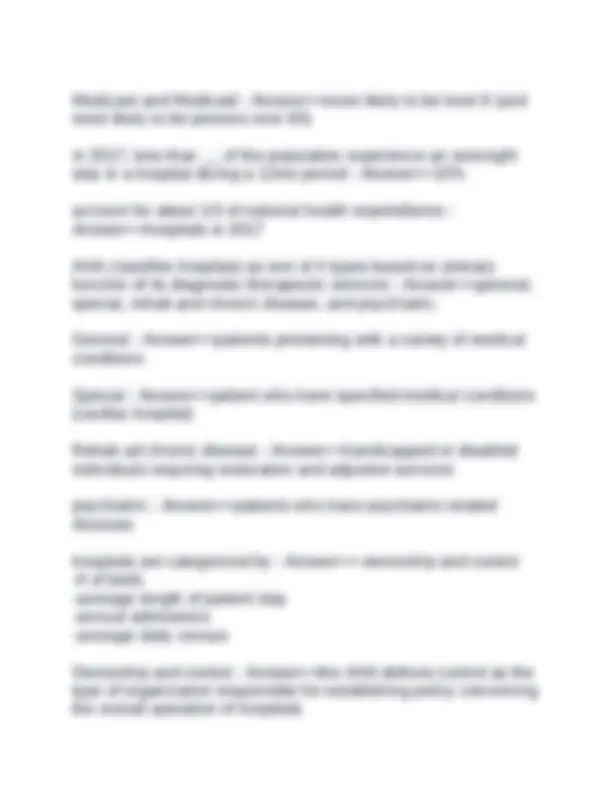
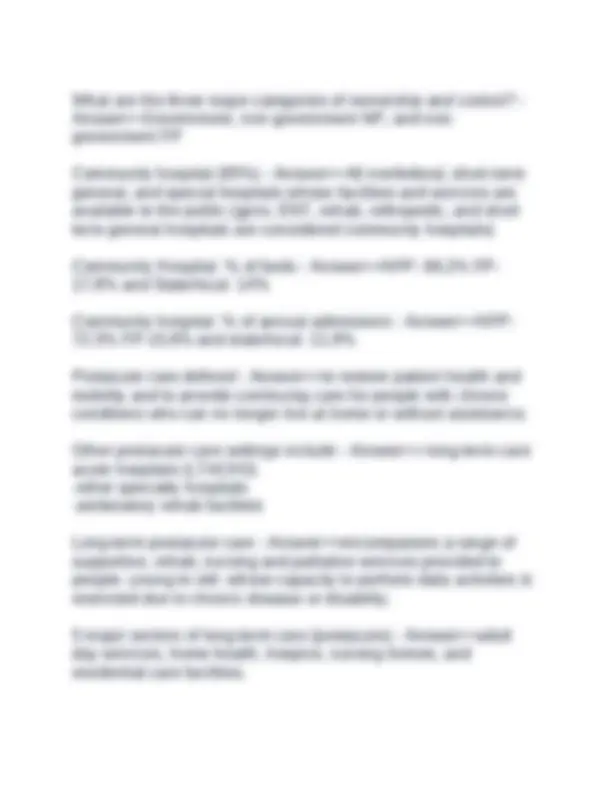
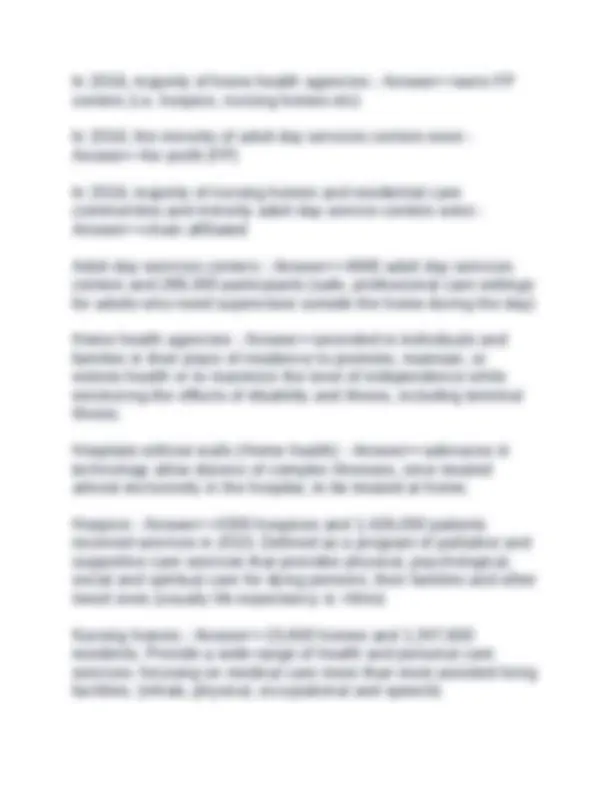


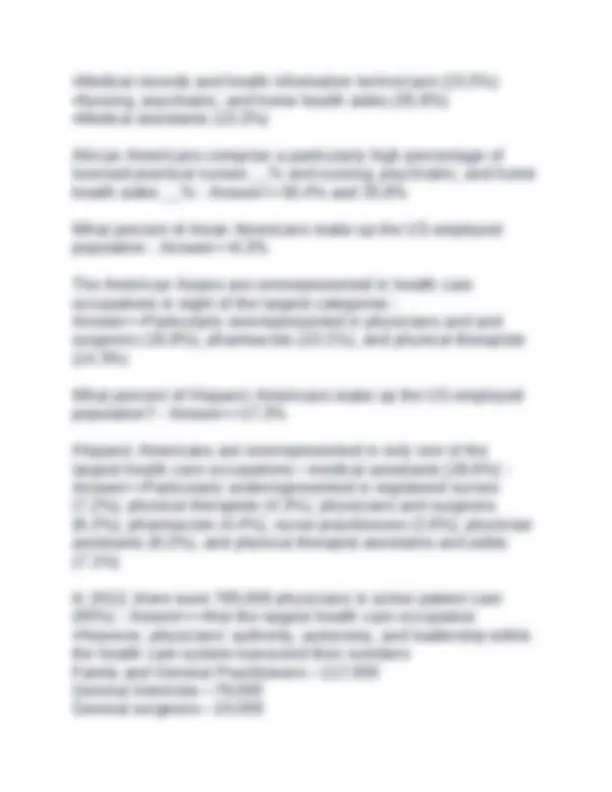
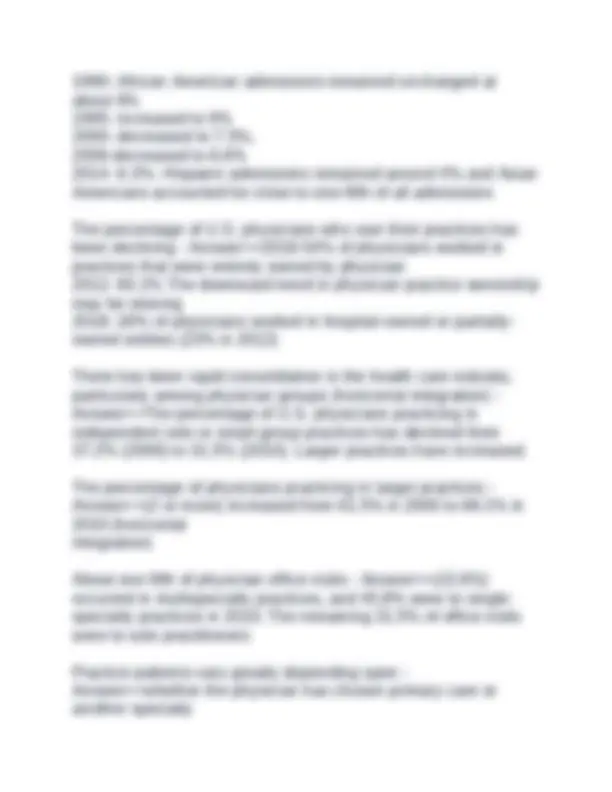
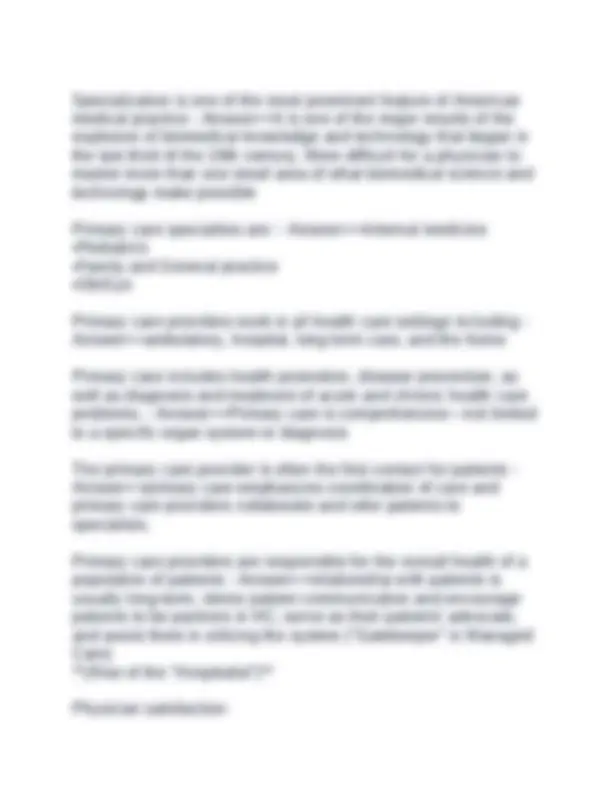
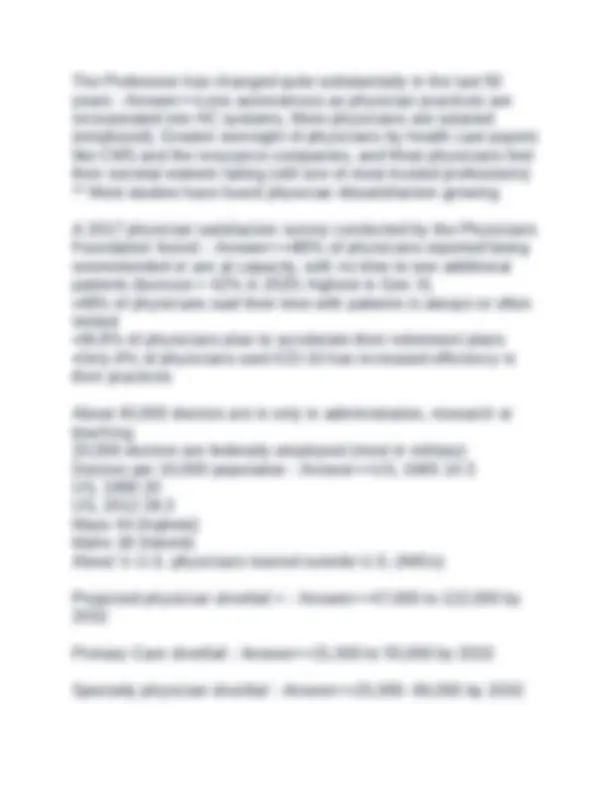
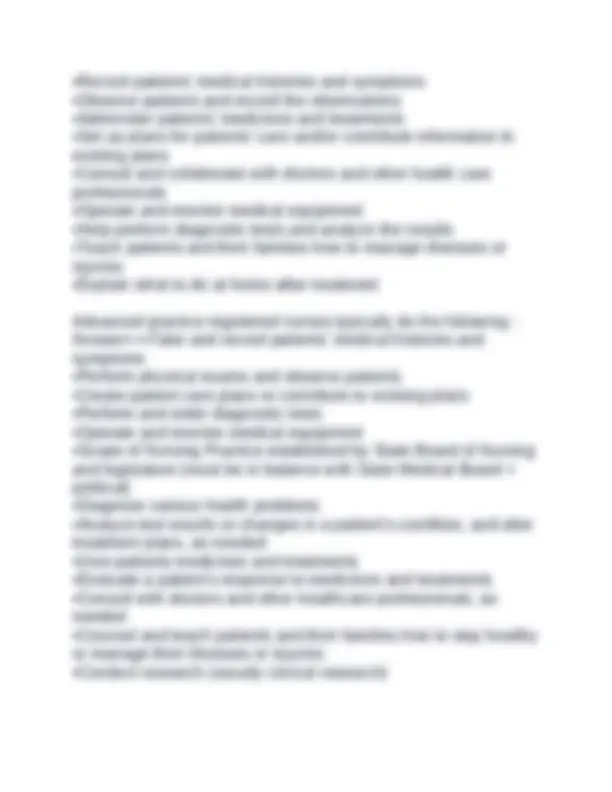
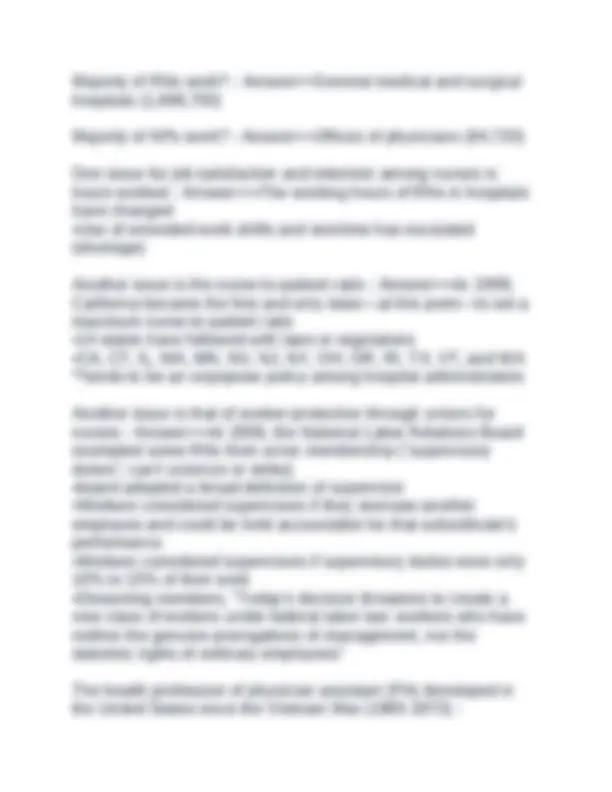
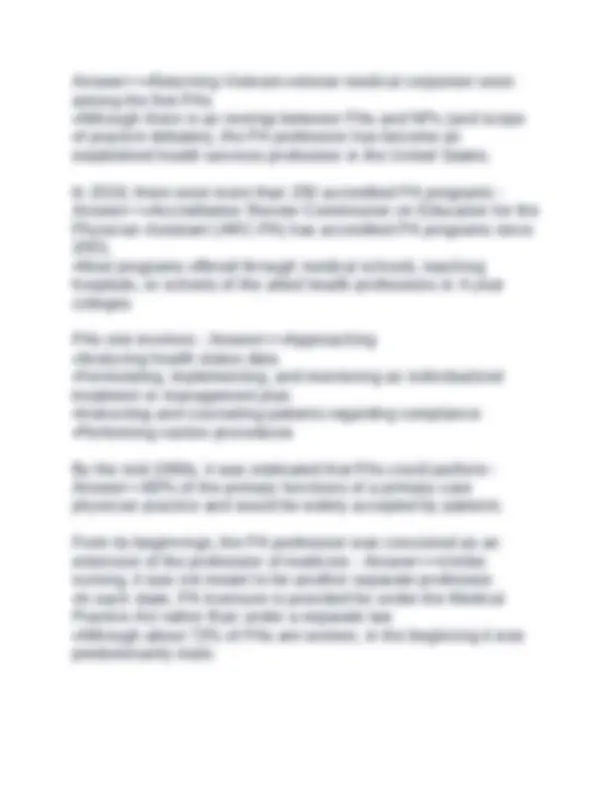
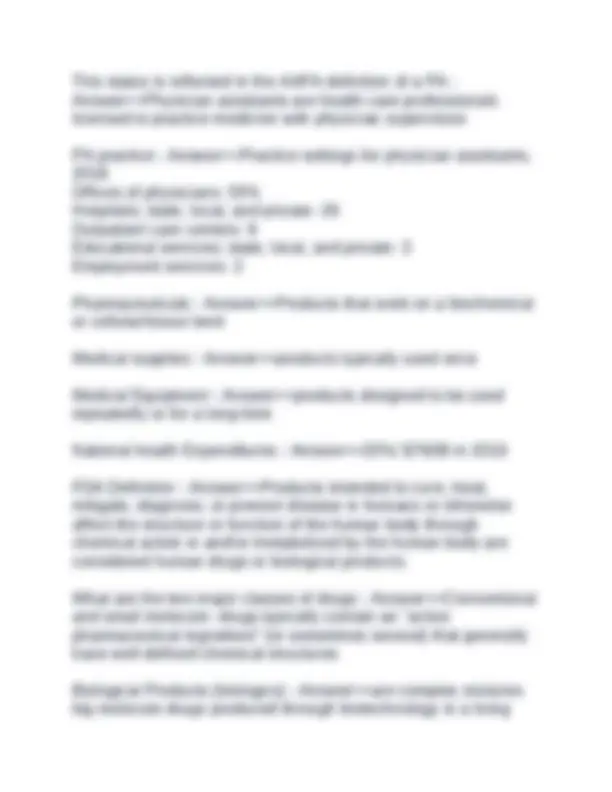
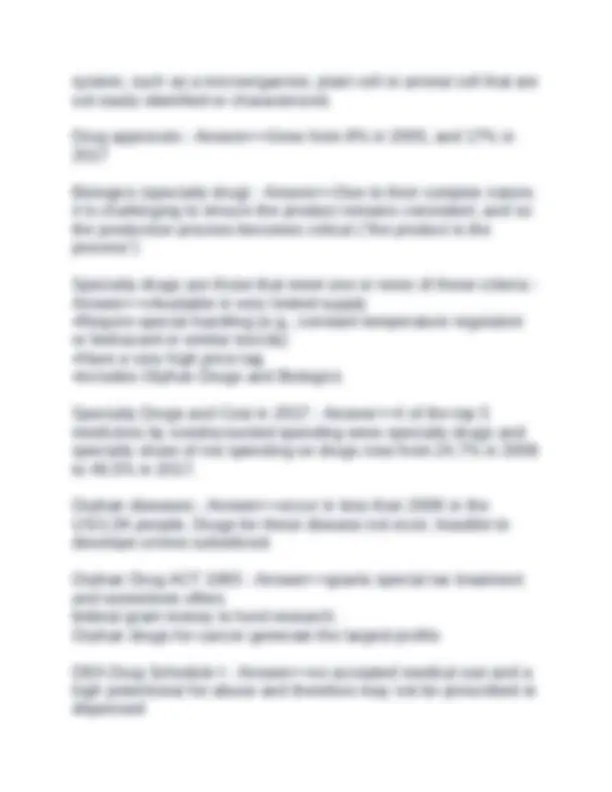
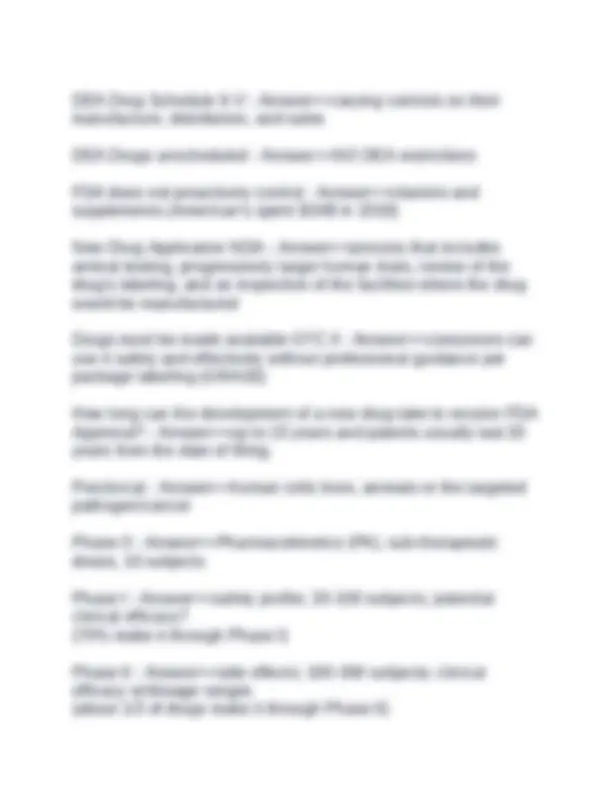
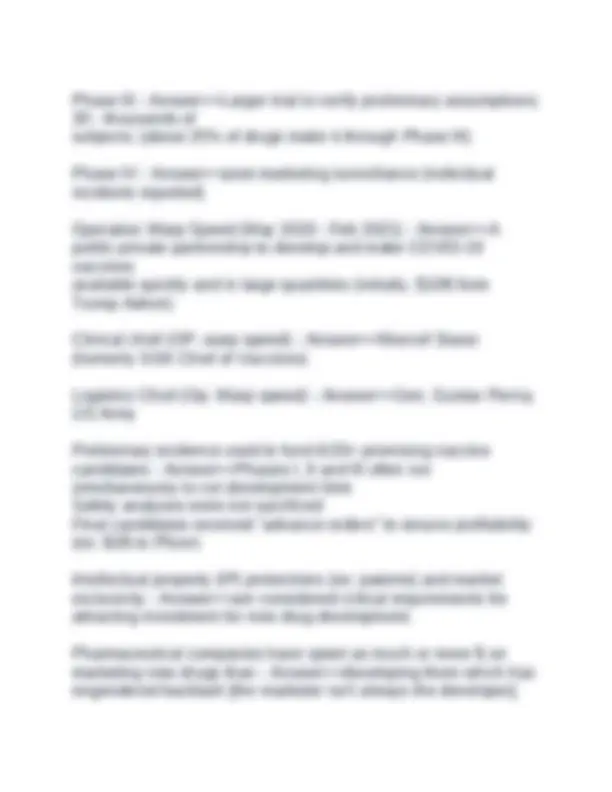

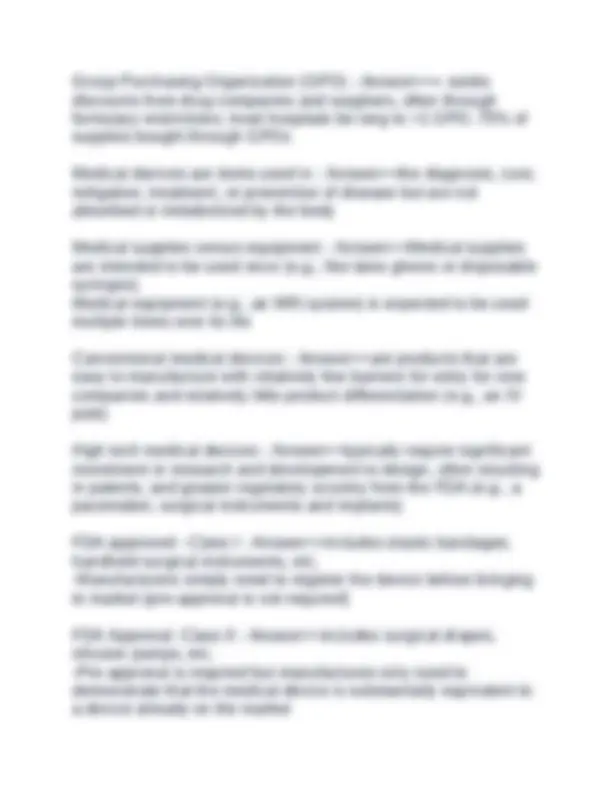
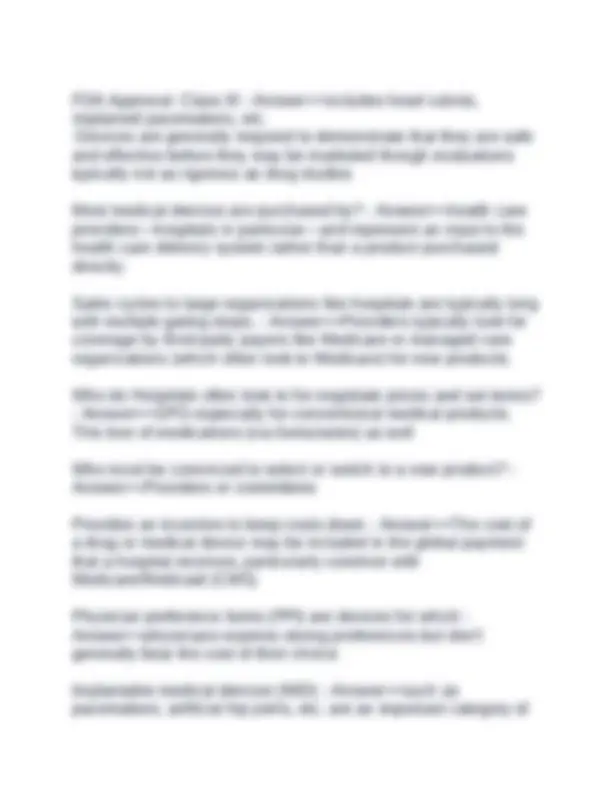
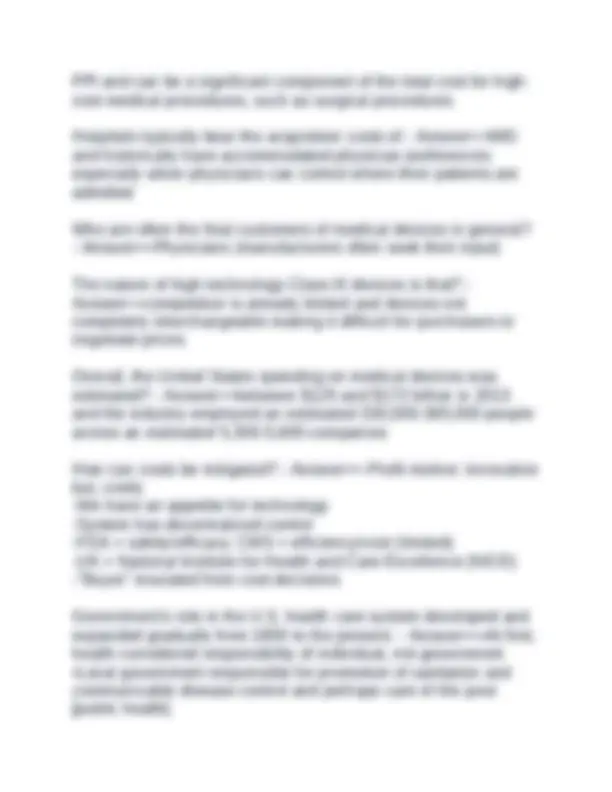
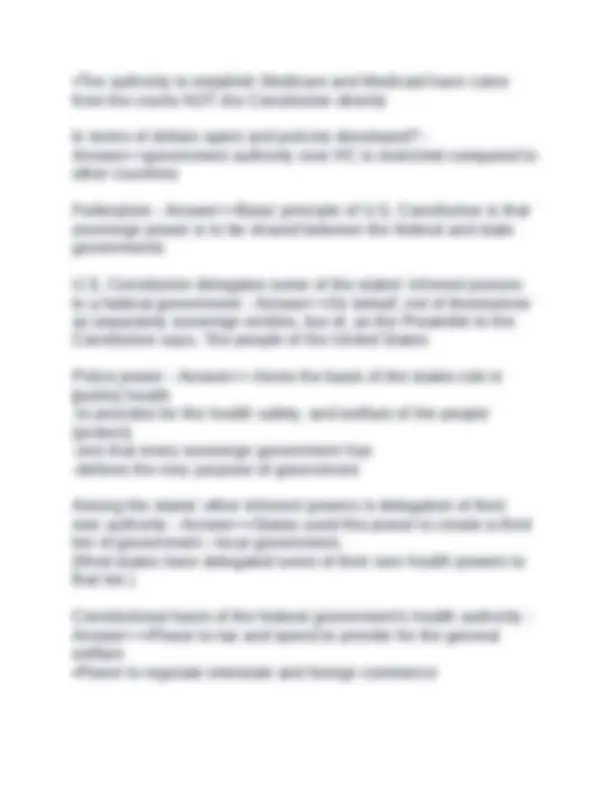
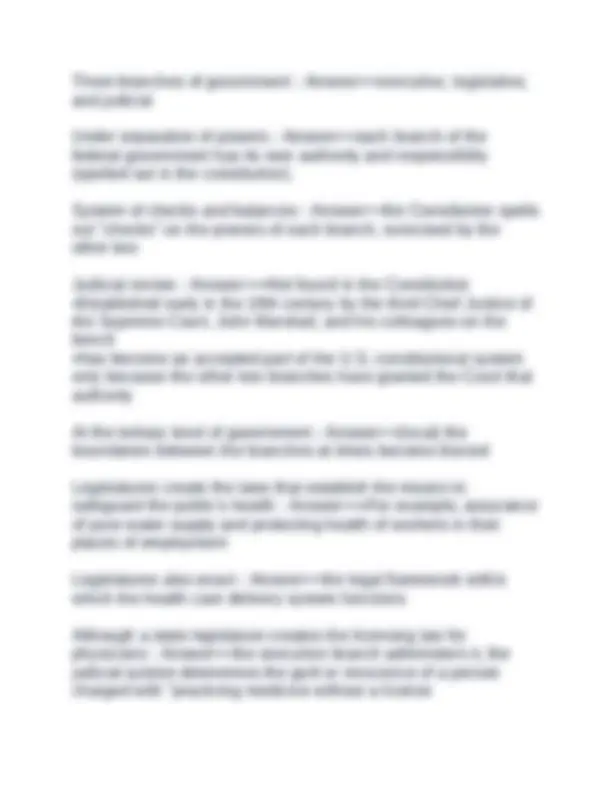
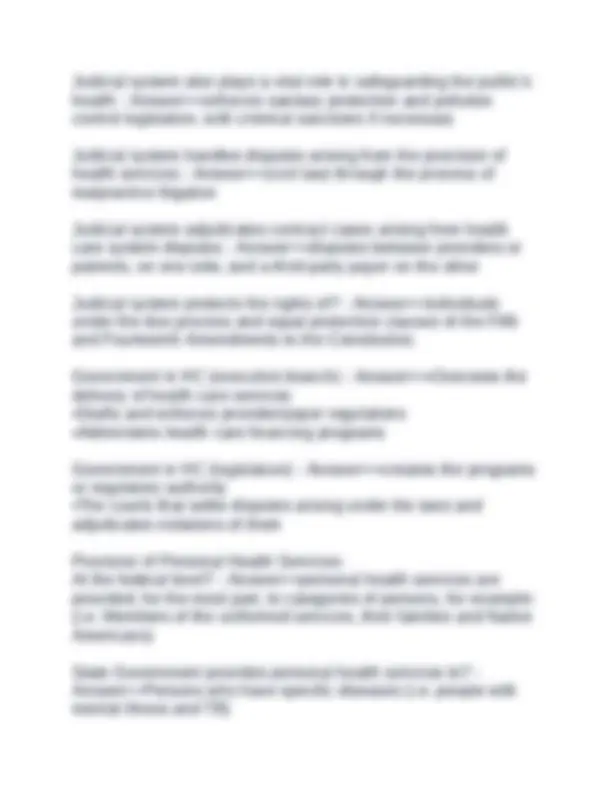
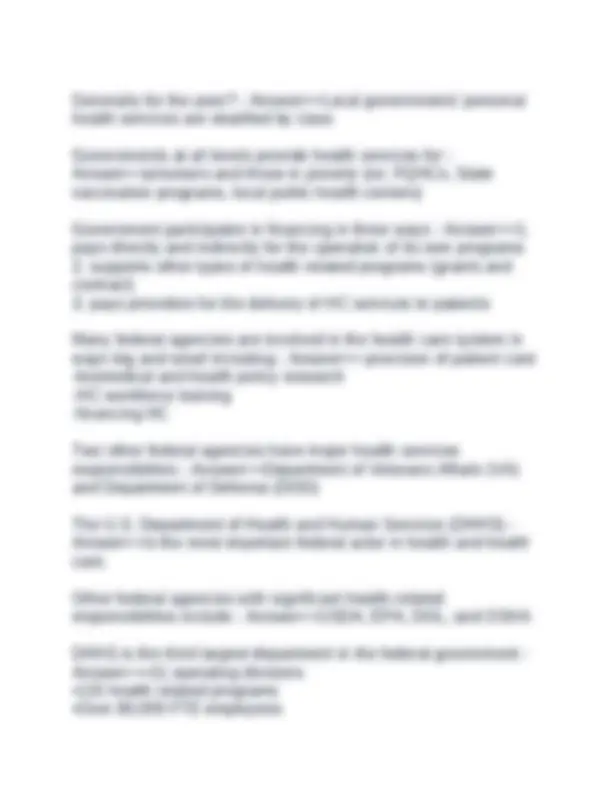
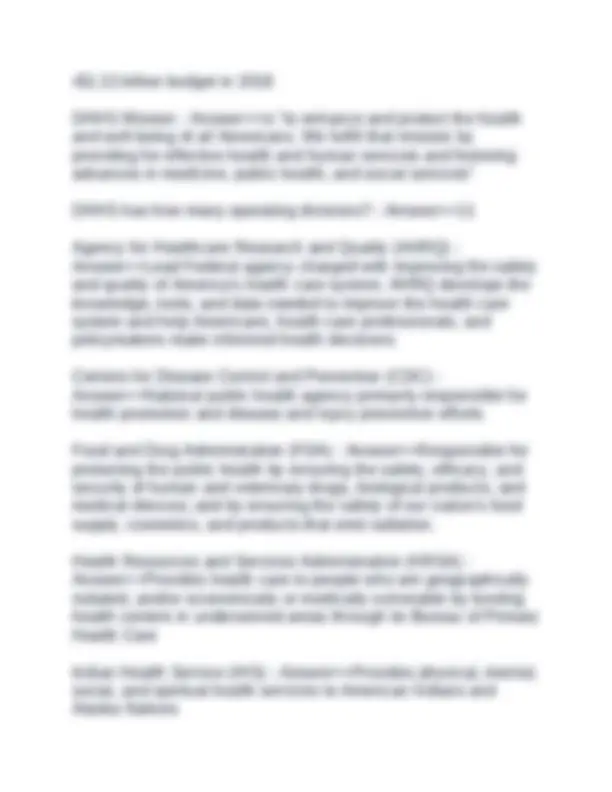

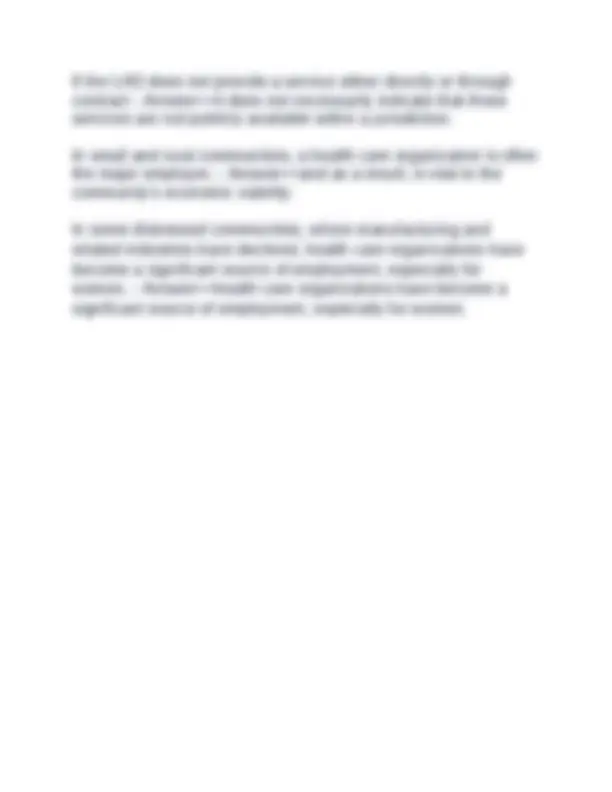


Study with the several resources on Docsity

Earn points by helping other students or get them with a premium plan


Prepare for your exams
Study with the several resources on Docsity

Earn points to download
Earn points by helping other students or get them with a premium plan
Community
Ask the community for help and clear up your study doubts
Discover the best universities in your country according to Docsity users
Free resources
Download our free guides on studying techniques, anxiety management strategies, and thesis advice from Docsity tutors
An overview of various aspects of the us healthcare system, including the number and types of nursing homes, adult day service centers, and home health agencies. It also covers the landscape of medical education, focusing on allopathic medical schools and the training regimen for physicians and nurses. The document emphasizes the importance of primary care and the roles of different healthcare professionals.
Typology: Exams
1 / 35

This page cannot be seen from the preview
Don't miss anything!




























Community-based care - Answer>>self and ambulatory care Hospital based care - Answer>>inpatient acute care Postacute care - Answer>>long-term care, ambulatory rehab centers, long term care hospitals Self-care (80-95% of health problems stop here) - Answer>>OTC meds, vitamins and supplements and change of habits Ambulatory healthcare - Answer>>medical services performed without admission to a hospital or other health care facility for an overnight stay Freq settings for ambulatory care - Answer>>physician offices, emergency departments, and hospital outpatient clinics Emerging and expanding ambulatory HC - Answer>>telehealth, physician home visits, retail pharmacies, diagnostic imaging and laboratory centers, ambulatory surgery centers, and urgent care centers Most freq reasons for visits - Answer>>general medical exam, routine prenatal, post op, medication, cough, well baby exams, hypertension, knee symptoms, and pre-op visit Majority of OVs in NE - Answer>>>65 and female Majority of ED - Answer>>visits occur in NFP 70.9%
How many ED visits are taught IN hospitals? - Answer>>around 15% in 2016, how many patients are insured - Answer>>the majority. 85% were private ins, Medicaid and Medicare. Only 8.4% had no ins. ED functions related to providing highly technical resources for acutely ill persons - Answer>>life threatening, prompt hospitalizations, and serve as secondary private physician's office. ED functions related to restricted access to HC - Answer>>cannot reach private physician, reg clinic is not open or available, geographically isolated, or have no ins so no place to go when sick. Top 3 reasons for visits to ED - Answer>>abdominal pains, chest pain, or fever Level of urgency- Level I - Answer>>Resuscitation Level of urgency- Level II - Answer>>emergent (likely to deteriorate and/or time sensitive) Level of urgency- Level III - Answer>>urgent (stable but complex) Level of urgency- Level IV - Answer>>semi-urgent (stable, one level of diagnosis or significant pain- lacerations/pain when voiding) Level of urgency- Level V - Answer>>non-urgent Most ED visits are considered? - Answer>>level 3 or level 4
What are the three major categories of ownership and control? - Answer>>Government, non-government NP, and non- government FP Community hospital (85%) - Answer>>All nonfederal, short-term general, and special hospitals whose facilities and services are available to the public (gyno, ENT, rehab, orthopedic, and short term general hospitals are considered community hospitals) Community Hospital- % of beds - Answer>>NFP- 68.2% FP- 17.8% and State/local- 14% Community hospital- % of annual admissions - Answer>>NFP- 72.3% FP-15.8% and state/local- 11.9% Postacute care defined - Answer>>to restore patient health and mobility and to provide continuing care for people with chronic conditions who can no longer live at home or without assistance. Other postacute care settings include - Answer>>-long-term care acute hospitals (LTACHS) -other specialty hospitals -ambulatory rehab facilities Long-term postacute care - Answer>>encompasses a range of supportive, rehab, nursing and palliative services provided to people- young to old- whose capacity to perform daily activities is restricted due to chronic disease or disability. 5 major sectors of long-term care (postacute) - Answer>>adult day services, home health, hospice, nursing homes, and residential care facilities.
In 2016, majority of home health agencies - Answer>>were FP centers (i.e. hospice, nursing homes etc) In 2016, the minority of adult day services centers were - Answer>>for profit (FP) In 2016, majority of nursing homes and residential care communities and minority adult day service centers were - Answer>>chain-affiliated Adult day services centers - Answer>>4600 adult day services centers and 286,300 participants (safe, professional care settings for adults who need supervision outside the home during the day) Home health agencies - Answer>>provided to individuals and families in their place of residence to promote, maintain, or restore health or to maximize the level of independence while minimizing the effects of disability and illness, including terminal illness. Hospitals without walls (Home health) - Answer>>advnaces in technology allow dozens of complex illnesses, once treated almost exclusively in the hospital, to be treated at home. Hospice - Answer>>4300 hospices and 1,426,000 patients received services in 2015. Defined as a program of palliative and supportive care services that provides physical, psychological, social and spiritual care for dying persons, their families and other loved ones (usually life expectancy is <6mo) Nursing homes - Answer>>15,600 homes and 1,347, residents. Provide a wide range of health and personal care services- focusing on medical care more than most assisted living facilities. (rehab, physical, occupational and speech)
A few core ideas guide HC occupations including: - Answer>>Primum non nocere (do no harm), providing care competently, maintaining confidentiality of patients and their records (HIPAA), respecting patient autonomy and primacy, and engaging with patients and fellow workers honestly. Health care workers in every occupation are a? - Answer>>Source of economic stability in many communities HC occupations also offer a gateway to middle class life for - Answer>>unskilled workers through support positions earned in noncollege settings Nursing assistants are - Answer>>persons with only a HS diploma or equivalent, trained to assist, are carry out basic patient care, and their training can lead to more skilled and well-paying jobs. HC Occupations amount to a large and increasing portion of employed US persons - Answer>>In 2018, about 13 million people, or 8.5% of all civilians employed in nonagricultural occupations and in 2002, about 9 million, or 6.8% The Bureau of Labor Statistics has 2 major categories of HC workers - Answer>>practitioners and tech occupations and HC support Occupations. Major categories of HC occupations do NOT include - Answer>>•Medical and Health Services Managers (n = 372,670) •Health Educators (n = 58,780) •Postsecondary Health Teachers (n = 255,190), Postsecondary Health Specialties Teachers (n = 199,480), and Community Health Workers (n = 56,130)
How many people in 2018 were employed in "practitioners and technical occupations" - Answer>>9 million (virtually all of these careers require licensure or certificate) Largest occupations (practitioner and technical) - Answer>>78% total. •Registered nurses (n = 2,951,960) •Health practitioner support technologists and technicians (n = 801,590) •Licensed practical and licensed vocational nurses (n = 701,690) •Therapists (n = 687,790)—occupational, physical, radiation, respiratory, exercise + Largest Occupation (practitioner and technical cont.) - Answer>>•Physicians and surgeons (n = 826,000 ) •Diagnostic-related technologists and technicians (n = 390,630) •Pharmacists (n = 309,550) •Medical records and health information technicians (n = 208,650) •Nurse practitioners (n = 179,650) •Physician assistants (n = 114,710) How many people are in HC Support Occupations? - Answer>> million- 77% total Largest in HC Support category - Answer>>•Nursing assistants (n = 1,450,960) •Home health aides (n = 797,670) •Medical assistants (n = 673,660) •Physical therapist assistants and aides (n = 141,510) Doctor salary range - Answer>>$75,000- $900, NP average about how much of a DR? - Answer>>half RN wages - Answer>>rising steadily
•Medical records and health information technicians (15.5%) •Nursing, psychiatric, and home health aides (35.8%) •Medical assistants (15.3%) African Americans comprise a particularly high percentage of licensed practical nurses __% and nursing, psychiatric, and home health aides __% - Answer>>30.4% and 35.8% What percent of Asian Americans make up the US employed population - Answer>>6.3% The American Asians are overrepresented in health care occupations in eight of the largest categories - Answer>>Particularly overrepresented in physicians and and surgeons (19.8%), pharmacists (23.1%), and physical therapists (14.3%) What percent of Hispanic Americans make up the US employed population? - Answer>>17.3% Hispanic Americans are overrepresented in only one of the largest health care occupations—medical assistants (28.6%) - Answer>>Particularly underrepresented in registered nurses (7.2%), physical therapists (4.3%), physicians and surgeons (8.2%), pharmacists (4.4%), nurse practitioners (2.6%), physician assistants (8.2%), and physical therapist assistants and aides (7.1%) In 2012, there were 785,000 physicians in active patient care (95%) - Answer>>•Not the largest health care occupation •However, physicians' authority, autonomy, and leadership within the health care system transcend their numbers Family and General Practitioners—117, General Internists—79, General surgeons—24,
Anesthesiologists—31, Pediatricians—57, Obstetricians and Gynecologists—34, Floating in space - Answer>>440, In 2019, 154 fully accredited allopathic medical schools in the United States - Answer>>Allopathic (MD) medical schools in the United States and Canada accredited by a voluntary agency— Liaison Committee on Medical Education (LCME) •Comprised of representatives from the AMA and the Association of American Medical Colleges (AAMC) and their Canadian counterparts In 2019, 35 osteopathic (DO) medical schools - Answer>>DO schools accredited by the American Osteopathic Association (AOA) Most medical schools are attached to a university - Answer>>•Invariably a separate college with its own dean (or the equivalent) •Sometimes loosely linked with other health professional schools in a health sciences center •About 60% of the medical schools are part of state public universities and remainder private •All the medical schools receive substantial, although primarily indirect, financial support from the federal government Physician training regimen is long - Answer>>•Entry to U.S. medical schools usually requires a university bachelor's degree •"Undergraduate" medical education lasts another four years •"Graduate Medical Education" (GME) includes the residency experience, which last many years depending upon the specialty
1990- African American admissions remained unchanged at about 6% 1995- increased to 9% 2000- decreased to 7.5%, 2006-decreased to 6.6% 2014- 6.3% -Hispanic admissions remained around 4% and Asian Americans accounted for close to one-fifth of all admissions The percentage of U.S. physicians who own their practices has been declining - Answer>>2018-54% of physicians worked in practices that were entirely owned by physician 2012- 60.1% The downward trend in physician practice ownership may be slowing 2018- 26% of physicians worked in hospital-owned or partially- owned entities (23% in 2012) There has been rapid consolidation in the health care industry, particularly among physician groups (horizontal integration) - Answer>>The percentage of U.S. physicians practicing in independent solo or small-group practices has declined from 37.2% (2000) to 31.5% (2010). Larger practices have increased. The percentage of physicians practicing in larger practices - Answer>>(2 or more) increased from 61.5% in 2000 to 68.1% in 2010 (horizontal integration) About one fifth of physician office visits - Answer>>(22.6%) occurred in multispecialty practices, and 45.8% were to single- specialty practices in 2010. The remaining 31.5% of office visits were to solo practitioners Practice patterns vary greatly depending upon - Answer>>whether the physician has chosen primary care or another specialty
Specialization is one of the most prominent feature of American medical practice - Answer>>It is one of the major results of the explosion of biomedical knowledge and technology that began in the last third of the 19th century. More difficult for a physician to master more than one small area of what biomedical science and technology make possible Primary care specialties are: - Answer>>•Internal medicine •Pediatrics •Family and General practice •Ob/Gyn Primary care providers work in all health care settings including - Answer>>ambulatory, hospital, long-term care, and the home Primary care includes health promotion, disease prevention, as well as diagnosis and treatment of acute and chronic health care problems. - Answer>>Primary care is comprehensive—not limited to a specific organ system or diagnosis The primary care provider is often the first contact for patients - Answer>>primary care emphasizes coordination of care and primary care providers collaborate and refer patients to specialists. Primary care providers are responsible for the overall health of a population of patients - Answer>>relationship with patients is usually long-term, stress patient communication and encourage patients to be partners in HC, serve as their patients' advocate, and assist them in utilizing the system ("Gatekeeper" in Managed Care) (Rise of the "Hospitalist") Physician satisfaction-
Demographics - Answer>>population growth and aging are primary drivers of shortfall. Achieving population health goals - Answer>>goals (↓obesity, smoking, BP, cholesterol, glucose) would increase demand by 34,000 FTEs; Also achieving universal access Ø2:5 currently active physicians will be >65 y.o. within next decade Trend towards fewer weekly hours worked per physician; > younger; > female - Answer>>equates with 21,000 fewer active physicians by 2032 Within nursing, Registered Nurses (RNs) are the largest category
State nursing board establishes licensing; - Answer>>scope of practice set by state medical board (some states don't require physician supervision) 184 DNP programs in 2011 - Answer>>In 2018 = 354 programs There are more than 840 baccalaureate programs in the United States - Answer>>Total enrollment in 2014 in all nursing programs leading to the BSN was 320,074, an increase from 299,118 in 2013 In 2014, graduate nursing programs enrolled - Answer>>•113, students in master's programs •5,290 students in research-focused doctoral programs •18,352 students in practice-focused doctoral programs The landmark Institute of Medicine (IOM) 2010 report, The Future of Nursing, recommended - Answer>>At least 80% of nurses hold baccalaureate degree or higher by 2020, compared to 50% in
•Doubling number of nurses with a doctorate ANA 2003 - Answer>>"Nursing is the protection, promotion, and optimization of health and abilities, prevention of illness and injury, alleviation of suffering through the diagnosis and treatment of human response, and advocacy in the care of individuals, families, communities, and populations" ANA definition emphasizes and makes explicit the importance of - Answer>>•Understanding the patient's social context •Promoting social justice •Advancing scholarship for the practice of nursing RNs typically do the following: - Answer>>•Assess patients' conditions
Majority of RNs work? - Answer>>General medical and surgical hospitals (1,698,700) Majority of NPs work? - Answer>>Offices of physicians (84,720) One issue for job satisfaction and retention among nurses is hours worked - Answer>>•The working hours of RNs in hospitals have changed •Use of extended work shifts and overtime has escalated (shortage) Another issue is the nurse-to-patient ratio - Answer>>•In 1999, California became the first and only state—at this point—to set a maximum nurse-to-patient ratio •14 states have followed with laws or regulations •CA, CT, IL, MA, MN, NV, NJ, NY, OH, OR, RI, TX, VT, and WA **tends to be an unpopular policy among hospital administrators Another issue is that of worker protection through unions for nurses - Answer>>•In 2006, the National Labor Relations Board exempted some RNs from union membership ("supervisory duties"; can't unionize or strike) •board adopted a broad definition of supervisor •Workers considered supervisors if they oversaw another employee and could be held accountable for that subordinate's performance •Workers considered supervisors if supervisory duties were only 10% to 15% of their work •Dissenting members, "Today's decision threatens to create a new class of workers under federal labor law: workers who have neither the genuine prerogatives of management, nor the statutory rights of ordinary employees" The health profession of physician assistant (PA) developed in the United States since the Vietnam War (1965-1973) -
Answer>>•Returning Vietnam-veteran medical corpsmen were among the first PAs •Although there is an overlap between PAs and NPs (and scope of practice debates), the PA profession has become an established health services profession in the United States. In 2019, there were more than 250 accredited PA programs - Answer>>•Accreditation Review Commission on Education for the Physician Assistant (ARC-PA) has accredited PA programs since
•Most programs offered through medical schools, teaching hospitals, or schools of the allied health professions in 4-year colleges PAs role involves - Answer>>•Approaching •Analyzing health status data •Formulating, implementing, and monitoring an individualized treatment or management plan •Instructing and counseling patients regarding compliance •Performing routine procedures By the mid-1990s, it was estimated that PAs could perform - Answer>>80% of the primary functions of a primary-care physician practice and would be widely accepted by patients. From its beginnings, the PA profession was conceived as an extension of the profession of medicine - Answer>>•Unlike nursing, it was not meant to be another separate profession •In each state, PA licensure is provided for under the Medical Practice Act rather than under a separate law •Although about 72% of PAs are women, in the beginning it was predominantly male.